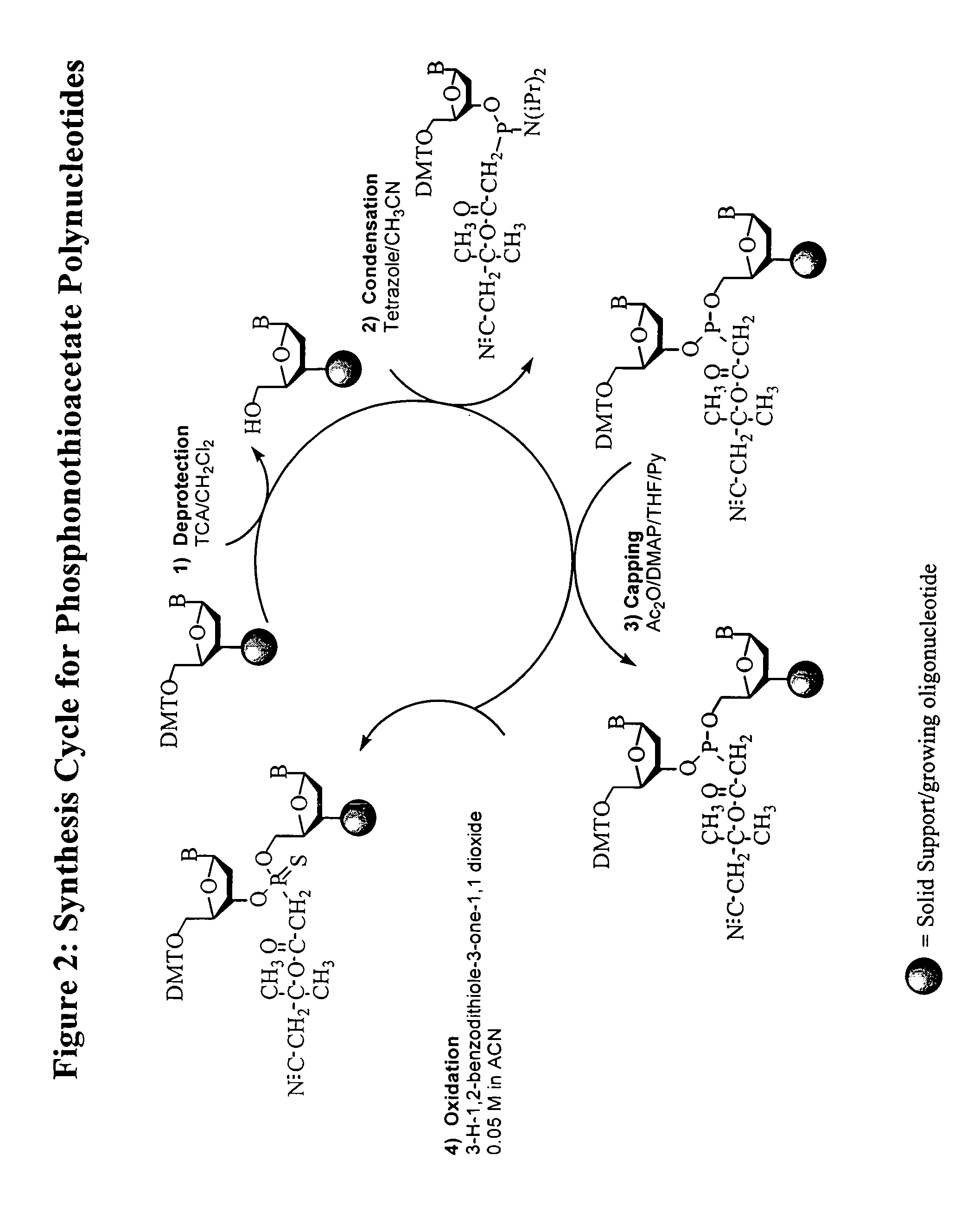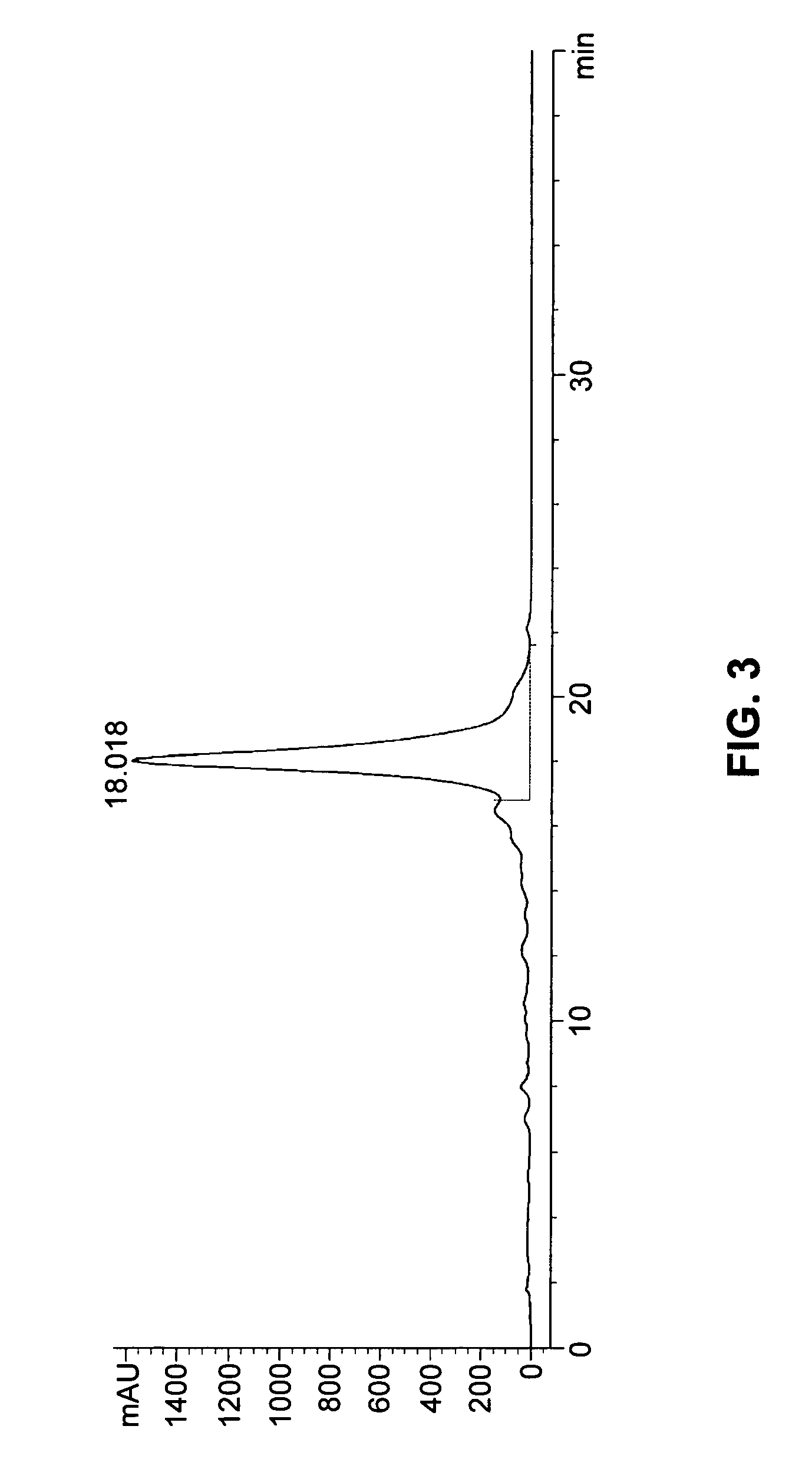Phosphinoamidite carboxylates and analogs thereof in the synthesis of oligonucleotides having reduced internucleotide charge
- Summary
- Abstract
- Description
- Claims
- Application Information
AI Technical Summary
Benefits of technology
Problems solved by technology
Method used
Image
Examples
example 1
Preparation of bis-(N,N-diisopropylamino)chlorophosphine
[0131]A 5-liter, 3-neck, round-bottom flask was equipped with a Fredrich's condenser, a ground glass stirrer bearing, a silicon rubber septum, and placed under dry argon. Two liters (1,600 grams, 15.9 mmols, 7.0 eq) of anhydrous diisopropyl amine was added to the flask. The diisopropyl amine was diluted by the addition of two liters of anhydrous acetonitrile. The solution was mixed with a mechanical stirrer attached to a glass stir rod and Teflon blade. An ice / water bath was placed under the 5-liter flask, and the amine solution allowed to cool for 30 min. Phosphorus trichloride (313 grams, 2.3 mmols, 1.0 eq) was dissolved in 1 liter of anhydrous acetonitrile in a separate dry 1-liter flask. The mechanical stirrer was set to vigorous stirring and the phosphorus trichloride solution added slowly to the stirring flask by cannula. Once the addition was complete, the ice / water bath was removed, and the reaction was allowed to warm ...
example 2
Synthesis of N,N-diisopropylamino dichlorophosphine
[0132]Bis-(N,N-Diisopropylamino) chlorophosphine, 10 grams (37 mmols), was dissolved in 500 ml of anhydrous acetonitrile. Phosphorus trichloride, 5.16 grams (37 mmols), was added to the solution and the reaction was allowed to stir over-night at room temperature. The reaction was assayed for completion by 31 P NMR of an aliquot of the reaction using an external lock. Complete conversion of the starting material at δ 134 ppm to the product at δ 165 ppm was observed. The solvent was evaporated from the reaction mixture on a rotary evaporator and the resulting oil distilled under vacuum yielding 5.7 grams of product (81% yield).
example 3
Synthesis of Acetic acid, (bis-N,N-(diethylamino)phosphino)-methyl ester
[0133]A 500 ml 3-neck round bottom flask was equipped with a reflux condenser, magnetic stir bar and two addition funnels. 13.1 grams, 200 mmol of granular zinc was placed in the bottom of the flask. Bis-(N,N-diethylamino)chlorophosphine (21.1 grams, 100 mmol) and methyl bromoacetate (14.1 grams, 100 mmol) were each dissolved in 200 ml of anhydrous ether. The two ether solutions were placed in the dropping funnels and the reflux condenser fitted with a dry argon line. 30 ml of each solution was ran into the round bottom flask and the mixture stirred vigorously. The reaction mixture was heated with a heat gun until the ether boiled. The heat was kept on the mixture until the reaction mixture became clear and slightly yellow. At this point, the reaction continued to boil without addition of heat due to the exothermic nature of the reaction. Steady addition of the two ether solutions kept the reaction at a vigorous...
PUM
 Login to View More
Login to View More Abstract
Description
Claims
Application Information
 Login to View More
Login to View More - R&D
- Intellectual Property
- Life Sciences
- Materials
- Tech Scout
- Unparalleled Data Quality
- Higher Quality Content
- 60% Fewer Hallucinations
Browse by: Latest US Patents, China's latest patents, Technical Efficacy Thesaurus, Application Domain, Technology Topic, Popular Technical Reports.
© 2025 PatSnap. All rights reserved.Legal|Privacy policy|Modern Slavery Act Transparency Statement|Sitemap|About US| Contact US: help@patsnap.com



